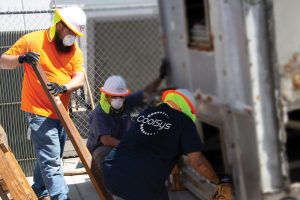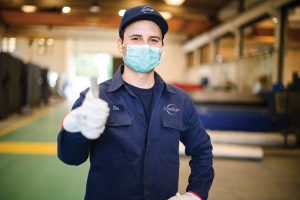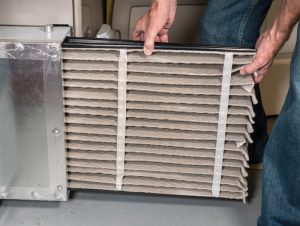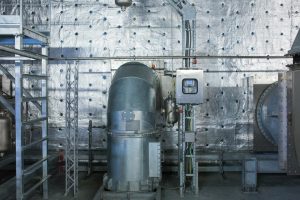— By Clive Samuels —
Creating safer and healthier indoor air quality.
The spotlight is on indoor air quality as COVID-19 continues to change the way we look at the world. While there is more to learn about SARS-CoV-2, there is strong evidence that it spreads through the air from person to person.1 As a result, consumers and employees are aware — perhaps more than ever before — of the importance of safe and healthy indoor air quality.

Clive Samuels, CoolSys
Viruses present a difficult challenge for air sanitizing and filtering systems. Unable to move on their own, viruses require a carrier — such as droplets of water that come from the nose and mouth when a person coughs, sneezes, laughs, shouts, sings or even speaks. Gravity pulls larger droplets to nearby surfaces; however, the tiniest virus-carrying droplets, called aerosols, can linger in the air and travel on air currents. At only about 0.1 microns in diameter2 — a miniscule dot compared with the size of molds, allergens and even bacteria — SARS-CoV-2 can slip through many filters intended to trap indoor particulates.
Fortunately, emerging technologies boost the ability of commercial HVAC systems to control airborne pathogens. None of these technologies are 100% effective; however, when properly installed and maintained, they can have a dramatically positive impact on indoor air quality.
 This white paper discusses five technologies. The practicality, cost and effectiveness of these technologies depends on building size, installation, usage, HVAC system and other factors. These solutions should not be used as the first line of defense against COVID-19 but rather should be considered secondary environmental controls.
This white paper discusses five technologies. The practicality, cost and effectiveness of these technologies depends on building size, installation, usage, HVAC system and other factors. These solutions should not be used as the first line of defense against COVID-19 but rather should be considered secondary environmental controls.
Two of the leading voices regarding COVID-19 and indoor air quality are the American Society of Heating, Refrigerating, and Air-Conditioning Engineers (ASHRAE) and the Centers for Disease Control and Prevention (CDC). Each organization offers COVID-19 best practice guidelines which can be found at the ASHRAE and CDC websites.
UV-C Lighting
The effectiveness of ultraviolet (UV) light in purifying surfaces is well known. Although all UV light can kill or deactivate pathogens, UV-C wavelengths — ranging from 100 to 280 nm (nanometers) — are the most effective. Specialized lights that emit UV-C can be installed to inactivate viruses, bacteria, mold and fungi.
Typically, these installations are in one of two locations: 1) in filtration systems within HVAC ducting and/or 2) outside of HVAC ducting. If the lights are installed outside of HVAC ducting, they should be positioned near the ceiling to prevent human exposure to UV radiation. In addition, the UV-C unit should be placed so that air recirculates across it, since one pass alone may not have the desired germicidal effect.3
Widespread testing has yet to be conducted on the ability of UV-C to eliminate SARS-CoV-2. However, it has proven successful in dealing with measles and tuberculosis, as well as other viruses that cause severe acute respiratory syndrome (SARS).4 Since ultraviolet germicidal irradiation (UVGI) does not physically remove neutralized pathogens from the air, UV-C lights must be used in conjunction with a proper filtration system.
Air Ionization
The technology behind air ionization takes a unique approach to capturing microscopic aerosolized droplets that may contain pathogens. The process — also known as bipolar ionization — “fattens up” virus particles to make it easier for filters to capture them. This is accomplished with high-voltage electrodes that split apart molecules of oxygen into positive and negative ions in a process called ionization. These unstable ions seek out other particles in the air to return them to a balanced state.
 As they encounter viruses, bacteria, molds, allergens, odorcausing gases, volatile organic compounds (VOCs) and other particulates, the ionized oxygen molecules grab hold and bind with them. In the process, dangerous pathogens are neutralized and can no longer infect a host, such as a human being. The larger-sized molecule that results can be more easily trapped in an air filter.
As they encounter viruses, bacteria, molds, allergens, odorcausing gases, volatile organic compounds (VOCs) and other particulates, the ionized oxygen molecules grab hold and bind with them. In the process, dangerous pathogens are neutralized and can no longer infect a host, such as a human being. The larger-sized molecule that results can be more easily trapped in an air filter.
Air ionization technology has already been proven to neutralize several different viruses.5 More recently, a scientific study in Spain found that the technology drastically decreased the amount of a virus similar to SARS-CoV-2 that passed into a simulated hospital ward.6 This study helped to confirm that, when combined with traditional filtration and good ventilation, air ionization can massively decrease the spread of COVID-19.
In fact, Philip Tierno, a clinical professor of microbiology and pathology at the NYU School of Medicine, told Business Insider that air ionization “…can reduce 99.9% of microbes in a matter of minutes.” 7
Air ionization units are typically easy to integrate with existing HVAC systems and are relatively inexpensive to install. They are a powerful, cost-effective solution for sanitizing indoor air. In addition, air ionization may reduce the need for outdoor air in the overall system, although a trained professional is required to make this determination.
Air Filtration
A study from Harvard’s T.H. Chan School of Public Health found that an increase in air pollution of fine particulate matter of only 1 μg/m3 (one microgram per cubic meter of air) is associated with an 8% increase in the COVID-19 death rate.8 In other words, there is strong evidence that proper air filtration helps to control the spread of COVID-19 in indoor air.
 The effectiveness of an air filter to capture and hold airborne particles is expressed by its minimum efficiency reporting value (MERV). The MERV of standard filters ranges from 1 to 16; the higher the number, the better the filtering. ASHRAE reports that filters with a MERV of 13 or higher are efficient at capturing airborne viruses, and that a MERV of 14 or above is preferred.9
The effectiveness of an air filter to capture and hold airborne particles is expressed by its minimum efficiency reporting value (MERV). The MERV of standard filters ranges from 1 to 16; the higher the number, the better the filtering. ASHRAE reports that filters with a MERV of 13 or higher are efficient at capturing airborne viruses, and that a MERV of 14 or above is preferred.9
HEPA (high-efficiency particulate air) and ULPA (ultra-low particulate air) filters go beyond the effectiveness of the highest-rated MERV filters to block bacteria and viruses in indoor air circulation. HEPA filters are required to remove 99.97% of particulates 0.3 μm (microns) in size.10
Upgrading the MERV of existing air filters may be a relatively inexpensive solution if efficient filters are already part of the HVAC system; however, it is important to consult a professional before making these changes. Increased air pressure from the higher-MERV filters can have a detrimental effect on an HVAC system if it is not sufficient to handle these filters.
High Ventilation
Proper ventilation is a best practice for indoor air quality. While it is not enough on its own to prevent transmission of COVID-19, mixing a higher than normal amount of conditioned outdoor air into recirculated air can improve indoor air quality11 as part of a broader strategy to reduce the spread of viruses and other dangerous particulates.
Important considerations in this strategy include the level of allergens and pollutants in the outside air, as well as extremes of temperature and humidity in the area where the building is located. In some limited situations, increased ventilation can be effectively achieved simply by opening windows and doors.
However, a better solution in most cases is to use an air economizer within the existing HVAC system and/or add a dedicated outdoor air system (DOAS), also known as a makeup air unit. A DOAS covers the deficit when an existing system is unable to match the recommended amount of ventilation, improving indoor air quality and helping control humidity inside a building year-round.
Humidity Control
It is common knowledge that maintaining optimal temperature and humidity creates a more comfortable environment. But it may be surprising to learn that staying within a proper range of humidity values also plays a role in minimizing the growth and spread of airborne pathogens.
 The tiniest droplets of virus, called aerosols, can travel long distances while suspended in the air. When these droplets encounter a hydrated host — such as a human being — they can rehydrate and spread. According to the American Society for Microbiology, an indoor relative humidity between 40% and 60% may help to defend against COVID-19 in two important ways.12 First, it may limit the spread and survival of the virus. Second, it may boost the body’s ability to filter out the virus by keeping mucus membranes hydrated and improving immune system functions.
The tiniest droplets of virus, called aerosols, can travel long distances while suspended in the air. When these droplets encounter a hydrated host — such as a human being — they can rehydrate and spread. According to the American Society for Microbiology, an indoor relative humidity between 40% and 60% may help to defend against COVID-19 in two important ways.12 First, it may limit the spread and survival of the virus. Second, it may boost the body’s ability to filter out the virus by keeping mucus membranes hydrated and improving immune system functions.
Using a humidifier within the HVAC system and/or dehumidifying the air with a reheat process or other technique can help achieve and maintain proper humidity.
References:
1 https://www.nytimes.com/2020/07/09/health/virus-aerosols-who.html
2 https://www.ncbi.nlm.nih.gov/pmc/articles/PMC7224694/
3 https://www.hindawi.com/journals/apm/2011/124064/ (section 3.4.2.)
5 https://www.ncbi.nlm.nih.gov/pmc/articles/PMC4477231/
7 https://www.businessinsider.com/bipolar-ionization-could-be-a-secret-weapon-against-covid-19-2020-4
8 https://projects.iq.harvard.edu/covid-pm
9 https://www.ashrae.org/technical-resources/filtration-disinfection
10 https://www.epa.gov/indoor-air-quality-iaq/what-hepa-filter-1
11 https://iaqscience.lbl.gov/vent-illness
12 https://msystems.asm.org/content/5/2/e00245-20
— Clive Samuels is president at CoolSys Energy Designs, a division of CoolSys, a parent company of HVAC and refrigeration companies nationwide. For more information, visit https://coolsysenergydesign.com/about-us/

